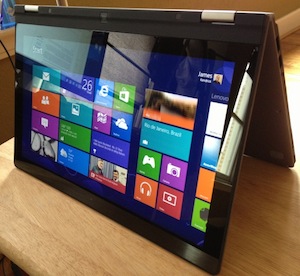The mobile hardware plateau: Driving bizarre form factors


Not that long ago mobile hardware makers were locked in a battle to produce hardware that jumped over the competition. Mobile processors led the charge in this battle with OEMs racing to be the first to market with products sporting the latest and fastest hardware.
The processor race ran hand-in-hand with graphic hardware innovation as companies sprinted to bring good video capability, namely HD features, to mobile products. Laptops, tablets, and smartphones were rushed to market with varying HD video capability in an attempt to release devices better than the rest.
We've reached a plateau in the mobile hardware world that is making it hard for vendors to set their products apart from the crowd. Mobile processors are now so powerful they can handle anything expected on a mobile device. Dual-core and quad-core processors are the standard on everything from phones to laptops.
There is a mobile hardware plateau, and it is indeed a plateau, that makes it difficult for mobile device makers to produce products that stand out in the crowded field.
Integrated graphics are now found on everything that can handle the most demanding HD video playback and recording. High-resolution graphics are now the standard on all mobile devices and are expected by savvy consumers.
To go along with the powerful processors and graphics, storage memory on mobile devices is now measured in gigabytes. Even the least expensive smartphones have tons of storage and system memory.
This mobile hardware plateau, and it is indeed a plateau, makes it difficult for mobile device makers to produce products that stand out in the crowded field. It's the same in all mobile device categories: smartphones, tablets, and laptops.
The only hardware criteria OEMs can use to make products different is form factor. That's why we are seeing a rash of gadgets in different sizes and form factors. Consumers aren't demanding devices of all shapes and sizes, the OEMs are looking to be different and that's the most visible way to do so.
Because of the hardware plateau we have giant smartphones like the Samsung Note 2. The company is making something that is obviously different from the competition's smaller handsets. They even threw in a stylus, an old-school accessory, to round out the differentiation.
That's also why we currently see a boatload of smaller tablets. The original iPad's success in the market led to a lot of competing tablets but the hardware was similar. Smaller tablets were the only real way to visibly stand out in the crowded tablet market so they are appearing everywhere.
Nowhere in the mobile space is the hardware plateau so impactful as in the laptop segment. Not too long ago laptop makers were able to make thinner clamshell devices to stand out. Now everything is thin so we are seeing bizarre forms. Laptops are appearing in droves that are bendy, twisty devices that can be used in rather strange ways.
I'm pretty sure consumers haven't demanded a laptop that can be used in "tent mode", but we're starting to see multiple products offering that very thing. Producing a thin laptop is not unique enough so OEMs are making them work in strange and in some cases uncomfortable ways. Consumers aren't asking for this, it's just happening because the hardware inside the devices is all the same.
The hardware plateau is why we are seeing so many "hybrids", the thin laptops that bend and twist around to become a tablet. This isn't new, Tablet PCs have been around for a decade. Consumers didn't demand them then, they didn't buy them in volume, and they aren't demanding them now. That's not stopping them from appearing in every laptop maker's product line.
As if these contorting laptops weren't bizarre enough, there's even one (so far) that has two separate displays. One display is used in standard laptop mode and the other activates when the screen is closed to become a tablet. Just what consumers wanted, a laptop with two screens but with only one active at a time. No matter that other hybrids simply twist the screen around so the one display is used in both laptop and tablet modes, this product has two displays adding cost and weight to the product.
It's understandable that OEMs have to scramble to make distinctive products since the hardware under the hood is basically the same. The hidden hardware is extremely powerful and everyone has it so they have to do something to be different.
Choice is a good thing so this is not a complaint, it makes it certain that every consumer will find a form and function they desire. It is fun to watch happen and to try and figure out what OEMs will come up with next to stand out. Some sort of folding Origami form that does who knows what I'll bet.
See related:
- Surface RT: A tweener device for Windows laptop users
- Surface: Is it "Microsoft's iPad", or something else?
- Hands on with Microsoft's Surface RT: Can it hit the sweet spot?
- New Samsung Chromebook and Series 5 500 Chromebook head-to-head
- Yes you can use the new Chromebook offline
- Samsung Chromebook in 3G slip out for $330
- New Samsung Chromebook: ARM processor and $249